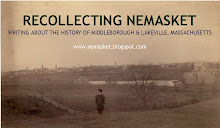.
Teachers in Middleborough were required to be present at least fifteen minutes prior to the commencement of school, both morning and afternoon. In the late 1800s, this requirement was shortened to ten minutes. Lessons for the day would have been prepared the previous afternoon or evening. Children arrived either on foot or, if lucky, by means of the farm wagon destined for town if “the trip might coincide with the time the children were to go to school.”
Because like most schools the Green School lacked a bell, the teacher rang a hand bell at the start of the day to call scholars to school. (The bell used at the Green from before 1861 through 1941 is now in the collections of the Middleborough Historical Museum). Students filed into the building using separate entrances. Hooks for coats and shelves for tin lunch pails were likely located immediately inside the entrance. “Clothing, that is outer garments such as coats, mufflers and leggings were hung on hooks outside the classroom door. Rubbers and rainboots or overshoes were placed at each side of your desk and under the metal leg support of the desk”, recalled one later Middleborough resident. Once inside the schoolroom, the children (at least in the early years of the school) were likely to have remained segregated by sex, the boys occupying one side of the schoolhouse and the girls the other.
Children were seated, sharing a double desk at the Green until 1904 when they were replaced with individual desks. Desks had “a slant top in which were kept the school books and any personal belongings [such as a pencil box]. Frequently the desks were made of oak and until the third grade there was a hole in the upper right corner. But when you entered the third grade you ‘grew up’ slightly” for at that stage students were permitted to write with pen and ink on paper and an inkwell filled the hole. (The inkwell could be a dangerous object. Frequently girls who wore their hair in pigtails might find them dipped into an inkwell by the mischievous boy behind her).
Typically, at the start of the day, an older boy would be delegated the responsibility of filling a water pail from either the Church of the Green or a willing neighbor which would be brought inside and left near the sink in the rear of the building. In winter, another would ensure that enough wood had been brought in to fuel the stove throughout the course of the day.
The first order of business was attendance. “The Roll shall be punctually called at the opening of each session, and each absentee shall be recorded at the time …”, stipulated the Middleborough School Committee in 1873.
“The morning services of the school shall commence with reading the Bible, and it is recommended that the reading be followed by some devotional service.” Like most schools of the era, those in Middleborough included a strong religious component, and the sessions were frequently referred to as “services” as in the foregoing quote. Moral instruction remained an important aspect of childhood education and the fact that Bible readings and moral lessons started off the day was an indication of their primacy within the school. Because of the importance of these services, pupils who were tardy were not permitted to enter the building at this time in order to avoid interrupting the “devotions.”
Following this, work by all ability levels commenced simultaneously. While some students read, others might work on copy books, while still others would perform blackboard work.
In order to reduce the chaos which could easily result in a classroom with so many students of varying abilities, teachers were urged to unite students in groups based upon their skill levels in each subject. “By the use of supplementary reading matter, and by the topical method in other subjects, classes representing different grades may be brought together.” Additionally, educators frequently urged alternation between oral and written recitations for students, partly in order to ground students in the fundamentals of each, partly to avoid monotony on the students part, and partly because written recitation work freed the teacher to concentrate on other students.
All students were provided with a 15 minute morning and a 15 minute afternoon recess, while primary pupils received an extra recess each half day. Teachers were barred from withholding recess from students as punishment. Though students might be detained in the classroom during regular recess, they were to be provided with the same length recess apart from the other students.”
Lunch was promptly at noon. Undoubtedly, the teacher ensured that each student had clean hands, and for this purpose soap and a rough washcloth would have been kept by the sink. In winter, lunch pails might be placed upon the heating stove in order to warm lunches.
The afternoon session mirrored that of the morning in regard to class work, lasting until 3.30 or 4 or in the afternoon.
Subscribe to:
Post Comments (Atom)













+-+Copy.jpg)

+of+Smoky+Mountains+018.jpg)

No comments:
Post a Comment